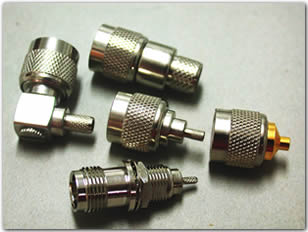 Prev
:: Top Prev
:: Top
|
| Threaded coupling interface ensures connector will not de-couple in vibration-intensive applications. |
| Many TNCs are recognized under the component program of Underwriter's Laboratories and have undergone stringent testing from an independent laboratory. |
| Performance from 0 - 11 GHz operations in many applications. |
| Antennas |
Telecom |
Base Stations |
Cellular |
| Cable Assemblies |
Mil-Aero |
Components |
|
| Instrumentation |
Radar |
Networks |
|
| Impedance |
50 Ω |
| Frequency Range |
0 - 11 GHz |
| Voltage Rating |
500 volts peak |
| Dielectric Withstanding Voltage |
1,500 volts rms |
| VSWR |
M39012 straight connectors: 1.3 max @ 0 - 11 GHzM39012
right angle connectors: 1.35 max @ 0 - 11 GHz |
| Contact Resistance |
Center contact: 1.5 mΩ; Outer contact: 0.2 mΩ |
| Insulation Resistance |
5,000 mΩ |
| Braid to Body |
0.1 mΩ |
| RF Leakage |
-60 dB minimum @ 3 GHz |
| Insertion Loss |
0.18 dB @ 9 GHz |
| Insulation Resistance |
= 5,000 MΩ |
| Mating |
7/16 threaded coupling |
| Braid/Jacket Cable Affixment |
Crimps: hex braid crimpClamps: screw-thread nut and braid clamp |
| Center Conductor Cable Affixment |
Crimps are crimp or solder; all other are solder only |
| Captivated Contacts |
All crimps unless specified otherwise |
| Cable Retention |
Crimps: 20 - 100 lbsClamps: 20 - 50 lbs |
| Male Center Contacts |
Brass, silver or gold plated |
| Female Center Contact |
Beryllium copper or phosphorous bronze, silver or gold plated |
| Other Metal Parts |
Brass with nickel finish (except for M39012 which are silver) |
| Insulator |
TFE, Delrin |
| Insulators |
TFE, Delrin |
| Clamp Gaskets |
Synthetic rubber, silicone rubber |
| Crimp Ferrule |
Copper |
| Temperature Range |
-65°C to +165°C |
| Weatherproof |
Clamps with clamp gaskets; crimps with heat-shrink tubing |
| Mermetic Seals |
Pass helium leak test of 2x10 -8 cc/second |
| Shock |
MIL-STD-202 method 202 |
| Vibration |
MIL-STD-202, method 204, test condition D |
| Moisture |
MIL-STD-202, method 106 |
| Corrosion |
MIL-STD-202 method 101, test condition B |
| Temperature Cycling |
MIL-STD-202, method 102, test condition D |
| Altitude |
MIL-STD-202 method 105, test condition C |
| MIL-C-39012 |
Where applicable |
Note: These characteristics are typical but may not apply to all connectors.

 Prev
:: Top
Prev
:: Top

